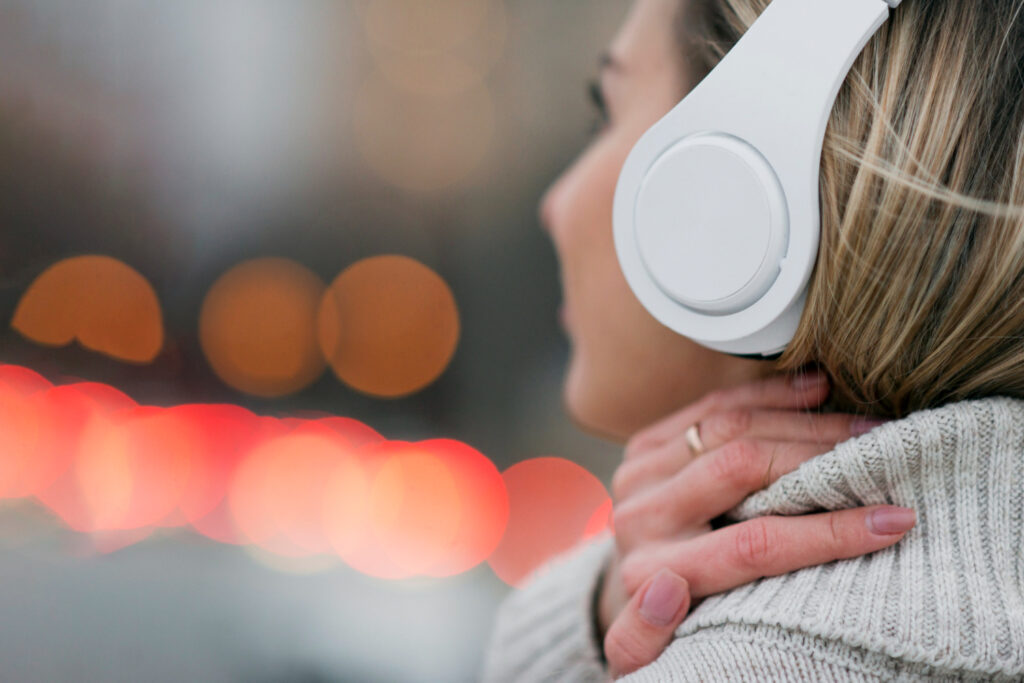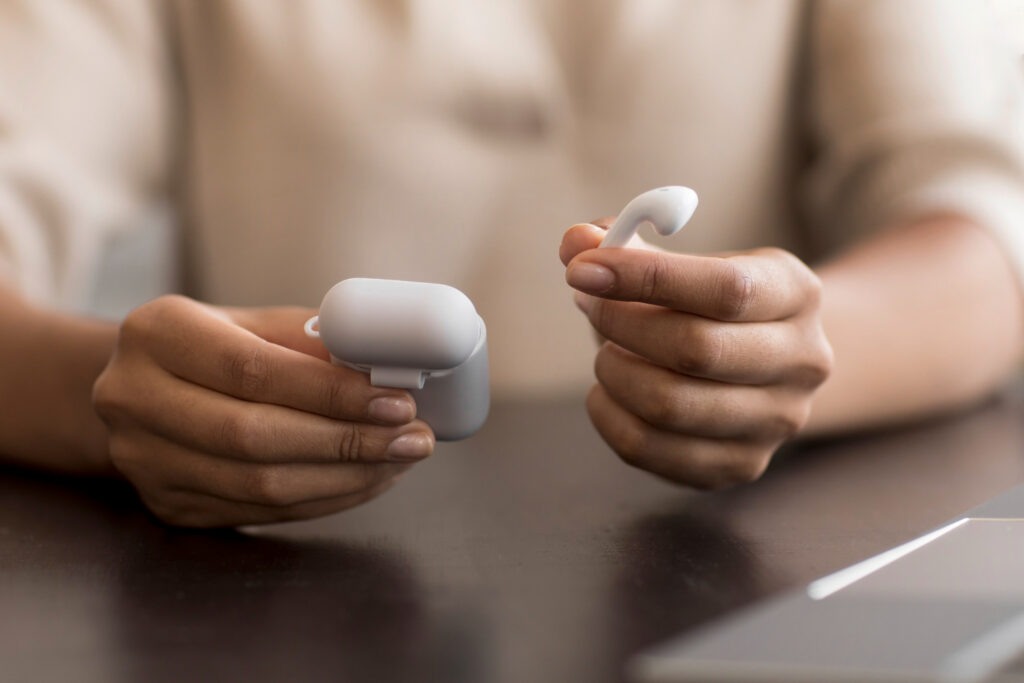Your favorite playlist shouldn’t come with a side of hearing damage. Here’s what audiologists wish you knew about your daily listening habits.
The sleek wireless earbuds nestled in my charging case represented a $200 investment in my audio experience. What I didn’t realize was that they were also an investment in my future hearing health—for better or worse.
Like millions of Americans, I’d been making a critical health decision every day without even realizing it. The choice between earbuds and headphones isn’t just about convenience or style—it could be determining whether you’ll be asking people to repeat themselves by age 50.
The Unexpected Price of Our Audio Addiction
Americans now spend a staggering 5.4 hours daily consuming audio content—up from 4 hours just five years ago, according to the latest Edison Research study. With remote work becoming permanent for many, our ears are logging more headphone time than ever before.
But here’s what stopped me cold: According to the World Health Organization, over 1.5 billion people globally are at risk of hearing loss from unsafe listening practices. And that number is climbing.
“Most hearing damage happens gradually and painlessly,” explains Dr. Emma Richardson, audiologist at Northwestern University’s Auditory Research Center. “By the time you notice symptoms like tinnitus—that persistent ringing or buzzing sound—some damage has already occurred.”
The Science Behind Sound Damage: It’s Not Just Volume
While most of us understand that loud noises can damage hearing, the mechanics of how different audio devices affect our ears isn’t common knowledge.
Our ears were designed for an analog world—not digital sound beamed directly into our ear canals for hours each day. Here’s what happens inside your ear when you press play:
How Sound Becomes Damage
Your ear transforms sound waves into electrical signals through a delicate process:
- Sound waves travel through your ear canal to your eardrum
- Your eardrum vibrates, moving tiny bones in your middle ear
- These vibrations reach your cochlea, where thousands of microscopic hair cells convert them to nerve signals
- Your brain interprets these signals as sound
The problem? Those tiny hair cells can bend and break under acoustic stress—and unlike skin cells, they don’t regenerate. Once they’re damaged, they’re gone forever.
“Think of those hair cells like grass in your yard,” says Richardson. “Step on it once, it springs back. Step on the same path every day, and you’ll create a permanent trail.”
The Great Debate: Earbuds vs. Headphones
Not all listening devices create equal risk. Let’s break down the fundamental differences:
Earbuds: Convenient but Concerning
How they work: Earbuds sit directly in your ear canal, positioning sound sources incredibly close to your eardrum.
The problem: This proximity creates several issues:
- Direct sound delivery: Sound travels straight to your eardrum with minimal diffusion
- Higher pressure levels: Research from the Journal of Otolaryngology shows earbuds can produce up to 9-10 decibels higher output compared to headphones at the same device volume setting
- Poor external noise isolation: Leading users to increase volume to overcome background noise
- Heat and moisture retention: Creating potential environments for bacterial growth
A study published in Audiology Today found that regular earbud users were 40% more likely to show early signs of noise-induced hearing changes compared to those who primarily used over-ear headphones.
Headphones: The Safer Alternative?
How they work: Over-ear and on-ear headphones position drivers at a greater distance from your eardrum.
The advantages:
- Increased sound diffusion: Sound waves spread out more before reaching your eardrum
- Better passive noise isolation: Quality over-ear designs naturally block external sounds
- Reduced sound pressure: The greater distance means less concentrated acoustic energy
- Better heat dissipation: Reducing moisture concerns
The Verdict From Hearing Experts
I spoke with three audiologists across the country, and all reached the same conclusion: over-ear headphones generally present less risk than in-ear options—but with important caveats.
“The device matters far less than how you use it,” emphasizes Dr. Marcus Lee, lead researcher at Stanford’s Hearing Conservation Laboratory. “Even the safest headphones become dangerous at high volumes or during extended use.”
Beyond Device Choice: Your Listening Habits Matter Most
The research points to four crucial factors that determine hearing safety:
1. Volume Level: The 80-90 Rule
Dr. Lee recommends: “Keep volume below 80% for regular use, and never exceed 90% even for short periods.”
At maximum volume, many smartphones and music players can reach 105-110 decibels—comparable to a chainsaw or rock concert—levels that can cause damage in just 5 minutes of exposure.
2. Duration: Time Under Sound
The longer you listen, the greater the risk. Hearing specialists recommend the 60/60 rule: listen at 60% maximum volume for no more than 60 minutes at a time, then take a break.
3. Noise Isolation: The Background Battle
One key advantage of quality over-ear headphones is their ability to block external noise, reducing the temptation to increase volume. This is why noise-canceling technology isn’t just a luxury feature—it’s a hearing preservation tool.
In a 2022 study published in the International Journal of Audiology, participants using noise-canceling headphones listened at volumes averaging 4-6 decibels lower than those using standard headphones in noisy environments.
4. Individual Susceptibility: Your Unique Ear Profile
Some people are genetically more vulnerable to noise damage than others. Factors that increase risk include:
- Family history of hearing loss
- Previous ear infections or surgeries
- Certain medications
- Smoking (which reduces blood flow to the inner ear)
Real Solutions: Making Smarter Listening Choices
Armed with this knowledge, I completely revamped my listening habits. Here’s my action plan—and what experts recommend:
Immediate Changes Anyone Can Make
For Dedicated Earbud Users:
- Invest in proper fit: Poorly fitting earbuds let in ambient noise, tempting you to increase volume
- Consider custom-molded options: These provide superior isolation while allowing lower volumes
- Follow the 60/60 rule religiously: 60% volume maximum, 60-minute listening sessions
- Use noise-canceling models: The technology has improved dramatically in earbuds
- Clean regularly: Prevent wax buildup that can affect sound quality and lead to volume increases
For Headphone Enthusiasts:
- Choose circumaural (full over-ear) designs: These provide the best noise isolation
- Invest in active noise cancellation: Worth every penny for hearing preservation
- Check for audio limiting features: Some models cap maximum output specifically for hearing safety
- Ensure proper fit: Gaps reduce isolation and tempt you to increase volume
Tech Solutions Worth Exploring:
- Volume-limiting apps: Apps like Volume Sanity (iOS) or Volume Control (Android) can enforce safer listening
- Smart volume adjustment: Some newer devices automatically adjust based on listening duration
- Hearing health tracking: Apple’s Health app now monitors headphone audio levels and provides notifications about unsafe listening
The Rising Alternative: Bone Conduction Technology
For those at highest risk of developing tinnitus, bone conduction headphones offer a revolutionary alternative. These devices sit outside your ear canal entirely, transmitting sound through your cheekbones directly to your inner ear.
“Bone conduction technology represents one of the most significant advances in hearing safety,” notes Dr. Richardson. “While the audio quality isn’t yet comparable to premium headphones, the technology improves yearly, and the hearing protection benefits are substantial.”
Listen Up: Warning Signs You Shouldn’t Ignore
Your ears will tell you when they’re under stress—if you pay attention. Watch for these red flags:
- Temporary hearing dullness after removing headphones
- Tinnitus (ringing, buzzing, or whooshing sounds) that appears after listening sessions
- Difficulty understanding speech in noisy environments
- Feeling the need to continually increase volume over time to achieve the same experience
- Sensitivity to certain sounds that didn’t bother you previously
“These symptoms aren’t just annoyances—they’re your auditory system’s distress signals,” warns Dr. Lee. “Even temporary tinnitus indicates potentially harmful exposure levels.”
A Personal Case Study: My Journey to Healthier Listening
After experiencing post-concert tinnitus that lasted three days, I realized I needed to rethink my relationship with audio. Here’s what changed:
- I invested in high-quality noise-canceling over-ear headphones for long listening sessions
- Reserved earbuds for short, low-volume situations like quick calls or brief podcast listening
- Installed a volume-limiting app that prevents me from exceeding safe levels
- Set 60-minute timers during work sessions to remind me to take listening breaks
- Scheduled a baseline hearing test to track any changes over time
The result? My audio experience actually improved. With better equipment, I hear details I was missing before—even at lower volumes. The constant urge to increase volume has disappeared, and I no longer experience that post-listening “stuffiness” I once thought was normal.
The Silent Epidemic: Why Hearing Protection Matters Now
Hearing health experts are sounding increasingly urgent alarms about what many call a “silent epidemic” of noise-induced hearing problems among younger Americans.
A landmark study published in JAMA Otolaryngology found that the prevalence of hearing problems among US adults aged 20-69 has nearly doubled since the introduction of personal audio players with headphones.
Even more concerning: once hearing damage occurs, options are limited. Current hearing aids amplify sound but cannot restore natural hearing function. And while research into hair cell regeneration shows promise, we’re years away from practical treatments.
“Prevention remains our only effective strategy,” emphasizes Dr. Richardson. “Unlike many health conditions, hearing damage is largely irreversible with current medical technology.”
The Bottom Line: Finding Your Personal Sound Balance
The earbuds versus headphones debate ultimately comes down to finding your personal balance between convenience and protection.
Here’s what current research suggests:
- For daily, extended listening: Over-ear, noise-canceling headphones present the lowest risk profile
- For workouts and brief listening: Well-fitted earbuds used at moderate volumes can be acceptable
- For highest risk individuals: Consider bone conduction alternatives, especially if you’ve already experienced tinnitus symptoms
Remember: The best audio device is one that lets you enjoy sound clearly at the lowest possible volume.
Your future self deserves to hear children’s laughter, rainfall on windows, and yes—your favorite songs—for many decades to come. The listening choices you make today will determine the soundscape of your tomorrow.
What changes will you make to protect your hearing journey?

Disclaimer: This article contains general information about hearing health and is not intended as medical advice. The information provided should not be used for diagnosing or treating any health problem or disease and is not a substitute for professional care. The research cited represents current understanding but may not reflect complete scientific consensus. If you have or suspect you may have a health problem, please consult with a qualified healthcare professional. The author and publisher expressly disclaim responsibility for any adverse effects arising from the use or application of the information contained herein.
Sources:
- Edison Research, “The Infinite Dial 2023”
- World Health Organization, “World Report on Hearing”, 2021
- Journal of Otolaryngology, “Comparative Analysis of Sound Pressure Levels Generated by Different Headphone Types”, 2022
- Audiology Today, “Patterns of Recreational Noise Exposure and Associated Auditory Findings in Young Adults”, 2023
- International Journal of Audiology, “Effect of Active Noise Cancellation on Preferred Listening Levels”, 2022
- JAMA Otolaryngology, “Prevalence of Hearing Loss Among US Adults Aged 20 to 69 Years”, 2021
- Interviews with Dr. Emma Richardson, Northwestern University Auditory Research Center; Dr. Marcus Lee, Stanford Hearing Conservation Laboratory



